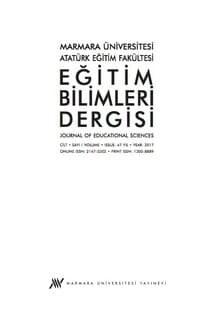ALMANYA’DA OKUL ÖNCESİ SİSTEMİ İÇERİSİNDE YÜRÜTÜLEN TÜRK/ALMAN İKİ DİLLİ EĞİTİM PROJELERİ ÜZERİNE BİR İNCELEME
Alman Okulları Eğitim Sistemi, 1948’den beri Batı Almanya’da geliştirilmiş olan eğitim yapılarına dayanmaktadır. 3-6 yaş arasındaki çocukların %90.7’sini eğitebilecek bir kurum kapasitesine sahip bir ülkedir. Almanya’da okulöncesi eğitimin ilkeleri, 1971 yılında Alman Eğitim Konseyi tarafından belirlenmiştir. Bunlar; okulöncesi dönem çocuklarına genel ve telafi edici teşviklerin sağlanması; okulöncesi dönem çocuklarına bireyselleştirme ve sosyal öğrenme imkanlarının sağlanması; anaokullarının genel eğitim sistemi içerisine dahil edilmesi ve okulöncesi eğitim programlarının hazırlanmasında, yeni araştırma sonuçlarından faydalanılması şeklinde sıralanabilir. Ortalama 85 milyon olan Almanya nüfusunun % 9’unu göçmenler oluşturmaktadır. Göçmenlerin geldikleri ülkeler incelendiğinde, ilk sırayı %28.8 ile Türkler; daha sonra sırasıyla %9.8 ile Yugoslavlar, %8.4 ile İtalyanlar, %5.0 ile Yunanlılar, %2.5 ile Avusturyalılar almaktadır. Almanya’da iki dille eğitim veren kurumlar mevcuttur. Almanya’da İki Dilli Eğitim Projesi’nden önce, 6. sınıftan sonra Türkçe’nin ilk yabancı seçmeli dil olması yönünde bir proje başlatılmış; ama bu proje maalesef yürümemiştir. Daha sonra ise İki Dilli Eğitim Projesi başlatılmıştır. Berlin’deki Türkçe/Almanca eğitim-öğretim veren iki dilli okulların sayısı yakın zamana kadar 36 iken, son istatistikler 9’a düştüğünü ortaya koymaktadır. Göçmen olarak Türklerin Almanya’daki yüzdeleri göz önünde bulundurulduğunda, bu sayı oldukça düşündürücüdür. Ailelerin iki dilli eğitimi tercih etmelerinin en önemli nedenleri; çocuğun anne-babasından birinin Türk veya Alman olması; diğer bir nedeni ise, Türk azınlığın sayısının Berlin de artış göstermesinden dolayı, Alman ailelerin çocuklarının oyun arkadaşları olan Türklerle kolay iletişim kurmalarını istemeleridir. Toplumsal hayata katılabilmek için Türk çocuklarının Almanca’ya hakim olmaları son derece önemlidir. Çocukların dil gelişimleri ne derecede gelişirse, okul hayatlarındaki başarı oranları da o denli yüksek olacaktır. Bu toplumda yaşadıkları için Almanca’yı öğrenmeleri; aynı zamanda neler olup bittiğini anlamaları ve kendi düşüncelerini dile getirebilmeleri gereklidir. Türkçe’yi ise, geldikleri toplumun ve ait oldukları kökenin deneyimlerini, duygularını, ilişkilerini ve değerlerini anlayabilmek ve aktarabilmek, ana babalarından gelen dili devam ettirebilmek için öğrenmeleri gerekmektedir. Bu makalede, Almanya’daki okul öncesi eğitim sistemi, İki Dilli Eğitim Projeleri ve Berlin’de İki Dilli Eğitim veren okul öncesi eğitim kurumlarının durumu genel olarak incelenerek, bu kurumlardan bazıları ile ilgili detaylı bilgi verilmekte ve öneriler sunulmaktadır. Anahtar Sözcükler : 2 dilli eğitim, okul öncesi eğitim, Alman eğitim sistemi.
An Investigation Into the Turkish/German Bilingual Education Projects Within the Early Childhood Education System in Germany
Germany is a country that has the capacity of those institutions, which can educate90.7% of the children between three and six years old. The regulations of early childhoodeducation were made by German Education Council in 1971.They can be listed asfollows; the provision of the general and compensatory supports, the condition of theindividual and social learning facilities for children prior to primary school, the inclusionof the kindergarten in the general education system and the use of current research resultsin the preparation of the early childhood education programs. The real goal of the earlychildhood education institutions in Germany is that they help children to becomeresponsible citizens in the society. According to the statistics were obtained at the end of1998, there were 7 320 000 emigrants in Germany. This number corresponds to 9% of theGerman population, which is 85 million in average. When the emigrants’ origin countriesare investigated, Turks are the first in order 28.8%; then Yugoslavians, Italians, Greeks,and Austrians are 9.8%, 8.4%, 5.0%, and 2.5% respectively.The project of selecting Turkish as a first elective language course after sixthclass had been started and dismissed prior to the Bilingual Education Project. Untilrecently, the Turkish/German bilingual schools numbered 36. However, according to thecurrent statistics, it has fallen down to 9. Considering the percentage of the Turkishpopulation in Germany, this number is relatively provocative. Families prefers thebilingual education project; the most important reasons for this are; being one of theparents of a child either German or Turkish and being ambitious of German families abouttheir children’s well communication with Turkish game friends as a result of the increasein numbers of the Turkish minority. In this paper, current situation of bilingual earlychildhood education institutions in Berlin will be described and some of those institutionswill be analyzed in details.In short, learning German and Turkish concurrently is extremely important forthe Turkish children. Since they live in this society, they should learn German, expresstheir own ideas and understand what has been going around them simultaneously. Theyalso should learn Turkish so as to maintain their parent’s mother tongue, understand andtransfer of the experiences, feelings, relations and values of the society and the origin,which they come from and are belong to. If their mother tongue is rejected at the nursery,they will feel that their origin and families are discarded. Therefore the emotionallyaggravated child either he/she refuses his/her family or he/she becomes introverted and will not want to learn anything. German children will have friends, whose mother tonguesare not German, in the neighbourhood. Consequently, they will taste the success ofunderstanding their friends’ language even slightly at both cultural relations. Thuschildren, as of their early childhood, notice the existence of various humans and languages in the world.Key words : Bilingual, education, pre-school education, German educationsystem.
